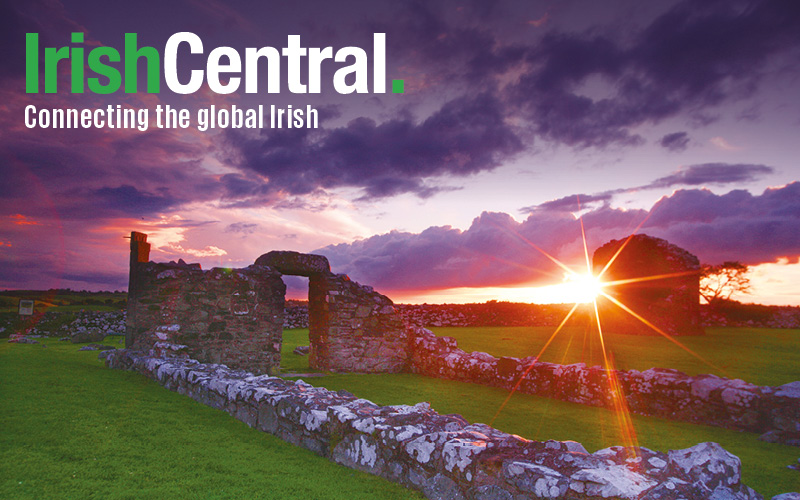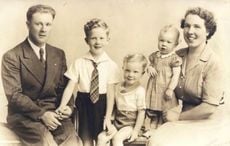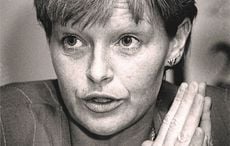It is a measure of how much Belfast still has to change that veteran taxi driver Paul Mac an Airchinnigh admits there are huge swathes of the city he knows nothing about even though he has driven a cab here for many years.
Most of the customers Paul picks up from his city center depot are based in the nationalist areas of West Belfast and they have no desire or need to cross the city to the Loyalist districts to the north and east of the city.
Paul (60) is no ordinary cab driver. He grew up on the Falls Road when hundreds of British soldiers used to patrol streets, which were dominated by military bases and lookout posts. He joined the IRA as a teenager at the height of ‘The Troubles’ and spent years as a political prisoner.

Paul Mac an Airchinnigh talks to a tour about the Bobby Sands mural. Photo: Ciaran Tierney
He knew nine of the ten men who lost their lives in the 1981 hunger strike at the notorious Maze Prison. He admits that he has no Protestant friends, although thankfully his two daughters – both in their 20s – have managed to cross that divide thanks to the improved social life brought about by the Good Friday Agreement in 1998.
Young people are mixing more in pubs and dance clubs but, as a former Republican prisoner, Paul would still feel uncomfortable about going for a pint just a few hundred meters away on the Loyalist Shankill Road.
Paul runs fascinating three-hour walking tours of the Falls Road these days, where tourists from all over the world learn about The Troubles and how difficult life was growing up in the predominantly Catholic part of the city.
Read More: How Belfast emerged from The Troubles much changed and strangely vibrant
“This is my truth, the story of Republican West Belfast, and you would get a completely different version of the truth if you talk to the people down there,” he tells our small group of four, pointing towards the Peace Wall between the Falls and Shankill, on a blustery weekday morning.
Paul is one of the founders of Coiste Irish Political Tours, a West Belfast organization run by former political prisoners which provides visitors with an unashamedly Republican guide to the conflict which scarred this area for 35 years.
He tells tourists, who are mostly from Australia and mainland Europe, about the Provisional IRA’s “war” with the British Army after the Catholic minority rose up in search of equal rights in Northern Ireland in the late 1960s.
The black taxi tours of Belfast’s trouble spots have become hugely popular in recent years, but Paul’s walking tour gives you an even greater grasp of how much the people of West Belfast felt they were living under siege.
Visitors are amazed by the quality of the striking murals on both sides of the wall, as Loyalist ex-prisoners also bring visitors on walking tours on the other side of the wall.
“A lot of people were doing the black taxi tours and a lot of the taxi drivers were telling the people complete and utter nonsense. No reflection on all the taxi drivers who do the tours, just some of them,” he tells me.
“And I was saying to myself that if I was a tourist I’d rather speak to somebody who was part of the conflict rather than somebody who heard stories from somebody in a pub or an old granny or something like that there.”
Paul says that Coiste was set up to provide ex-prisoners with employment and housing in the wake of the Good Friday Agreement in 1998. He enjoys the guided walks so much that he would love to give up the taxi-driving in order to do them full-time.
“Basically, the tours are about education. People come here with misconceptions about what the conflict was all about. They think it’s all just about Catholics and Protestants,” he tells me.
“There are so many different narratives to the conflict. You have the British narrative, the Unionist narrative, and the narrative which is most misrepresented, which is the Republican narrative. To me, as an ex-Republican prisoner, it’s important to tell our message about what the conflict was about.
“It’s up to people to take what they want out of the tours, but we are giving them a different perspective from what they have been given through the mainstream media through the years. That’s why our tours are important.”

A mural to the victims of the Troubles. Photo: Ciaran Tierney
People who've known Paul for years are surprised to see him escort tourists around the Falls Road, because he used to be known as a quiet and reserved man. But he feels it’s important to tell the story of his community and how the lives of so many were blighted by violence throughout The Troubles.
The beautifully painted murals tell the stories of hunger striker Bobby Sands, who was elected to the British Parliament in 1981; human rights lawyer Pat Finucane, who was murdered by a Loyalist death squad in 1989; and dozens of ordinary people who lost their lives in the conflict including teenagers killed by plastic bullets.
Paul quickly builds up a rapport with our small group as we tour the area at a leisurely pace, but he is keen to tell us why so many people supported the Provisional IRA when Northern Ireland erupted into violence in the late 1960s.
He has plenty of personal tales of youthful adventures, too, such as the night a British soldier pointed a gun at him when he tried to break into a teenage disco, without paying, at just 15 years of age.
Our tour ends at the Milltown Cemetery, scene of two of the worst atrocities of The Troubles, when Loyalist gunman Michael Stone attacked mourners at an IRA funeral and, days later, a group of mourners set upon two British soldiers when they drove into the middle of the funeral of one of Stone’s victims.
Mac an Airchinnigh’s vivid recollection of those awful days leaves our small group of tourists in no doubt that life has changed utterly for the better thanks to the peace process of the past two decades.
It was the killings at Milltown Cemetery which prompted Belfast-based journalist Una Murphy to leave her home city in 1988, as she felt she could not bring up her young family in such a violent and divided place.
Una spent years away from Belfast, in Dublin, Cork, and Cardiff, and laughs now as she recalls the sense of wonder in her mother’s voice after she rang her down in Cork to report that two Japanese tourists had been in the city center in 1996.
Read More: Belfast city's top 10 tourist attractions
“The phone rang and my mother was in awe, she said she had just seen two Japanese people with cameras outside City Hall,” recalls Una, with a smile. “In those days, tourists never came to Belfast.
“I came back to Belfast around the year 2000. It has taken a few years, but you can really notice the difference now. It’s normal to see so many tourists walking around the city center and we have had more cruise ships than ever in the harbor this year. During The Troubles, nobody really wanted to come here.”
Prior to 1998, and even for a few years after the peace process, the city center was deserted after 7pm every evening. People felt it was not safe to be out at night outside their own local neighborhoods.
Nowadays, tourists from all over the world mix with locals in city center bars, restaurants, and concert venues. There is a real sense of optimism and a multi-cultural vibe in the air.
Una arranges to meet me in the Sunflower Bar, north of the city center. The pub has become a poignant symbol of a changing Belfast. Three people lost their lives here, when the place was riddled with bullets in a sectarian attack.

Some Belfast humour on the gable wall of the Sunflower Bar. Photo: Ciaran Tierney
Today the bar, under new management, welcomes people of all creeds and nationalities. People come to the Sunflower for the wonderful music, or the pizzas on offer in the spacious beer garden, and nobody cares if you are a Protestant, Catholic, or dissenter.
With uileann pipes playing away in the background, a small group from Chile tell me they were spending an entire week in Belfast just because of the city’s thriving traditional music scene.
Across the river, the Titanic Quarter is one of the most vibrant tourist attractions in the whole of Europe. Visitors from all over the world spend up to four hours at the nine interactive galleries at the shipyard where the ill-fated passenger liner came to life before hitting an iceberg on her maiden voyage in 1912.
The exhibition is about so much more than one liner, as it looks at the history of Belfast City and the story of emigration in the 19th and 20th centuries, when so many Irish people sailed across the Atlantic to begin new lives in North America.

The Titanic Quarter, booming with life on the eastern banks of the Lagan. Photo: Ciaran Tierney
Looking around the massive, custom-built galleries, buzzing with so many visitors on a summer’s afternoon, it is hard to believe that tourists were such a strange curiosity to locals in Belfast as recently as two decades ago.
The tower blocks, military bases, and observation posts have been consigned to history, and booming Belfast – with its sad but colorful history and gorgeous nearby coastline – should certainly be on your ‘to do’ list if you are lucky enough to be visiting Ireland this year.
It’s now a brilliant place to visit, after so many years of turmoil and pain.
---
Ciaran Tierney is a journalist, blogger, and travel writer, based in Galway, Ireland. You can find his Facebook page here
This article was submitted to the IrishCentral contributors network by a member of the global Irish community. To become an IrishCentral contributor click here.




Comments